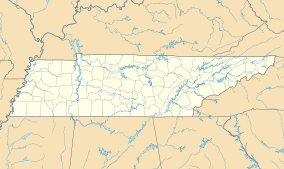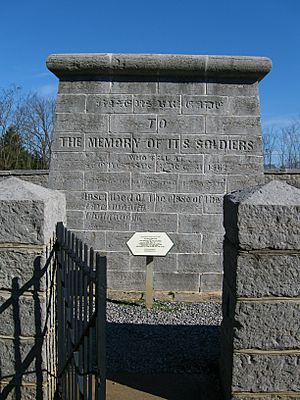Stones River National Battlefield facts for kids
Quick facts for kids Stones River National Battlefield |
|
|---|---|
|
IUCN Category III (Natural Monument)
|
|
| Location | Rutherford County, Tennessee, United States |
| Area | 709.49 acres (287.12 ha) |
| Established | March 3, 1927 |
| Visitors | 339,364 (in 2023) |
| Governing body | National Park Service |
| Website | Stones River National Battlefield |
The Stones River National Battlefield is a special park in Rutherford County, Tennessee. It covers about 570 acres (2.3 km2) along the Stones River. This park remembers the important Battle of Stones River from the American Civil War.
The battle happened on December 31, 1862, and January 2, 1863. It was a big win for the Union army. The park is located near Murfreesboro and Nashville.
Contents
Creating the National Battlefield
The idea for this national battlefield grew over many years. Different groups and people worked hard to make it happen.
Early Efforts to Preserve History
In the early 1900s, a railroad company helped promote the battlefield. They wanted more people to travel by train to visit the historic site. The company even bought parts of the battlefield. They also put up a tall monument in 1906. This monument remembers where Union cannons stopped a Confederate attack.
A group called the Stones River Battlefield and Park Association started in 1896. They wanted to save important Civil War battlefields. This group bought land options for about 3,400 acres (14 km2). They also put up wooden signs to explain different battle spots.
Becoming a National Park
Congress officially created Stones River National Military Park on March 3, 1927. It was first managed by the War Department. Later, in 1933, it moved to the National Park Service. This service is part of the U.S. Department of the Interior.
The park's name changed to a national battlefield in 1960. It was also added to the National Register of Historic Places in 1966. This list includes important historical sites.
Land for the park was bought between 1928 and 1934. In 1992, the park received a part of Fortress Rosecrans. This was a very large earth fort built during the Civil War. Today, the park protects less than a fifth of the original battle area.
In 2009, a tornado caused some damage to the park. Since 1997, the American Battlefield Trust has helped buy and protect more land. They have added about 74 acres (0.3 km2) to the battlefield.
Stones River National Cemetery
Inside the park is the Stones River National Cemetery. This cemetery covers about 20 acres (81,300 m2). It is the final resting place for 6,850 soldiers. Many of these soldiers, 2,562 of them, are unidentified.
Hazen Brigade Monument
Just outside the main cemetery is the Hazen Brigade Monument. This monument was built in 1863. It is the oldest Civil War monument still standing in its original spot. Another monument, the 32nd Indiana Monument, is a year older but is in a different cemetery.
How the Cemetery Was Created
Major General George H. Thomas ordered the cemetery to be built in 1864. Chaplain William Earnshaw oversaw the work. Soldiers from the 111th Regiment United States Colored Troops helped. They moved bodies from several battlefields to this new cemetery.
Reburials started in 1865 and finished by 1867. Most Confederate soldiers were buried in their hometowns. Some were later moved to a mass grave in Evergreen Cemetery in Murfreesboro. In 1867, more than 1,300 Union soldiers were moved here from another cemetery.
The cemetery was also transferred to the National Park Service in 1933.





